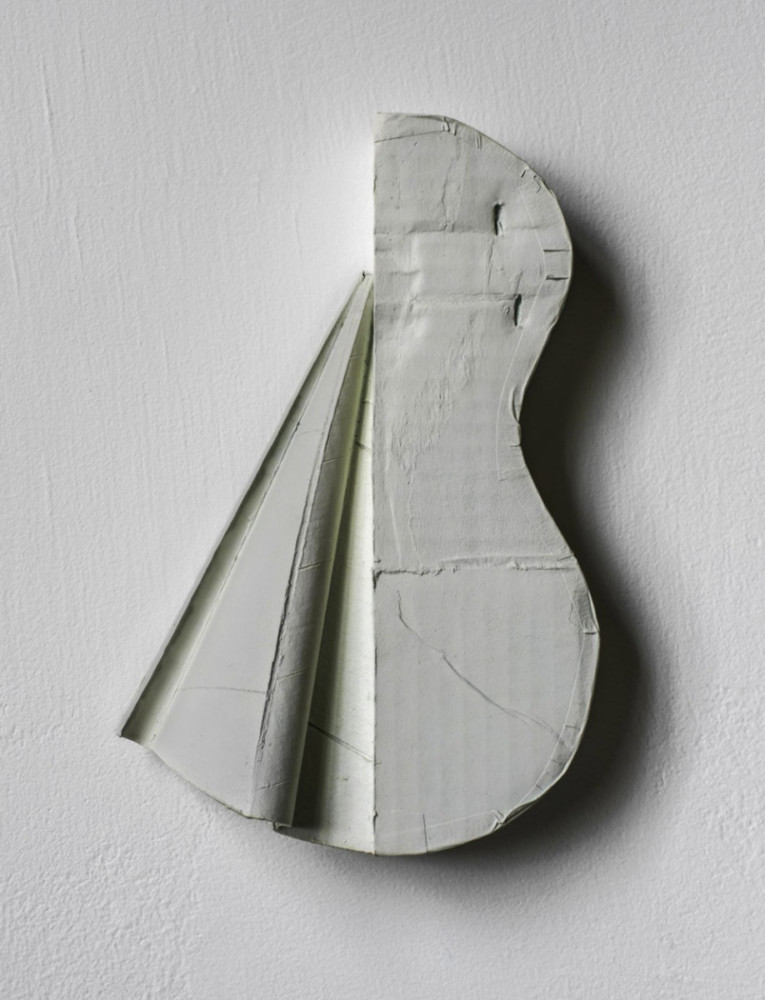Ricky Swallow at Stuart Shave/Modern Art, London (June 5 – 29, 2013) is a solo exhibition of new bronze sculptures that reflect the influences of 20th century design, studio ceramics and the inventiveness of folk art. There are also strong art historical references that deepen the work without weighing it down. Perhaps it is Swallow’s interest in the patched-up items that he finds in the flea markets in his home city of Los Angeles that keeps these sculptures fresh. He calls these flea market finds, “make-dos,” they are antiques that have been ‘creatively repaired or adapted – given an extended life rather than being discarded.’
Swallow may be best known for his hyper-realistic, carved wooden sculptures. His bronze work, though extremely technically rigorous as well, is ultimately more relaxed. He creates sculptures from cardboard, some of it fairly distressed, and casts them in bronze. This shift in his work reflects his interest in folk art, he has stated that the ‘economy of labour and materials toward something that’s a translation of a traditional object, a replacement of its former self, is something I love.’
This exhibition has fewer vessels than his previous show at Modern Art, London but the formal similarities between this work and slab constructed ceramics is keen. In a text that he wrote about the previous show for Artforum (February 2011), Swallow acknowledged the influence that ceramics has on his sculptures by writing, “most of my patina references come from ceramic glazes.” He went on to state:
There’s a quote I like by Ken Price where he talks about working with the cup as a form, and the ways in which it presents formal restrictions that create a structure to work within. He also speaks about the objects’ universal quality, how the cup can exist as its own subject matter… There’s a collective ownership and understanding that one brings to such recognizable forms.
This show may be more about other ‘recognizable forms’: art historical references abound. The fact that these sculptures are bronzes can’t be ignored. Futurism’s planes and skittering, repeated forms are present; the cardboard alludes to Arte Povera; and Picasso’s guitars aren’t so much alluded to as recreated. This may be more of Swallow’s “make-dos” ethos in practice—getting a little more life out of antiques.
Ricky Swallow, born in San Remo, Victoria, Australia in 1974, lives and works in Los Angeles, California. In 1997, he earned his BFA, with a major in drawing, from the Victorian College of the Arts, Melbourne, Australia. In 2005, Swallow represented Australia at the 51st Venice Biennale. Recent exhibitions include Ricky Swallow and Lesley Vance, The Huntington, San Marino, CA, USA (2012); Ricky Swallow: The Bricoleur, National Gallery of Victoria, Melbourne, VIC, Australia (2009); Younger than Yesterday, Kunsthalle Vienna, Vienna, Austria (2007); The Past Sure Is Tense, Art Gallery of Western Australia, Perth, WA, Australia (2006); and Ricky Swallow, PS1/MoMA, New York, NY, USA (2006). His work is held in many significant international public and private collections, including the Museum of Modern Art, New York; the University of California; Berkeley Art Museum, Berkeley, California; the Art Gallery of New South Wales, Sydney, Australia; the National Gallery of Victoria, Melbourne, Australia; the National Gallery of Australia, Canberra; the Museum of Contemporary Art, Sydney, Australia; and the Art Gallery of Western Australia, Perth.
Amy Albracht is the General Editor at CFile.
Above image: Ricky Swallow, Split Guitar with Drapery 1 (vertical), 2013. Patinated bronze. 11 x 8 x 15 in. Unique (MA-SWALR-00452). Photograph courtesy of Ricky Swallow and Stuart Shave/Modern Art, London.


Ricky Swallow, Exhibition views, Modern Art, London, 2013

Ricky Swallow, Skewed Doors, 2013. Patinated bronze. 14 1/4 x 7 1/4 x 2 1/2 in. Unique (MA-SWALR-00461).


Ricky Swallow, Reclining Guitar with Dials, 2012. Patinated bronze. 8 x 11 3/4 x 8 in. Edition 2 of 3 + 1 AP (MA-SWALR-00416).

Ricky Swallow, Saturn Cup, 2013. Patinated bronze. 3 1/4 x 7 x 6 1/4 in. Edition 1 of 1 + 1 AP (MA-SWALR-00455).


Ricky Swallow, Saturn Cup, 2013. Patinated bronze. 3 1/4 x 7 x 6 1/4 in. Edition 1 of 1 + 1 AP (MA-SWALR-00455).
Visit Stuart Shave/Modern Art in London

Add your valued opinion to this post.